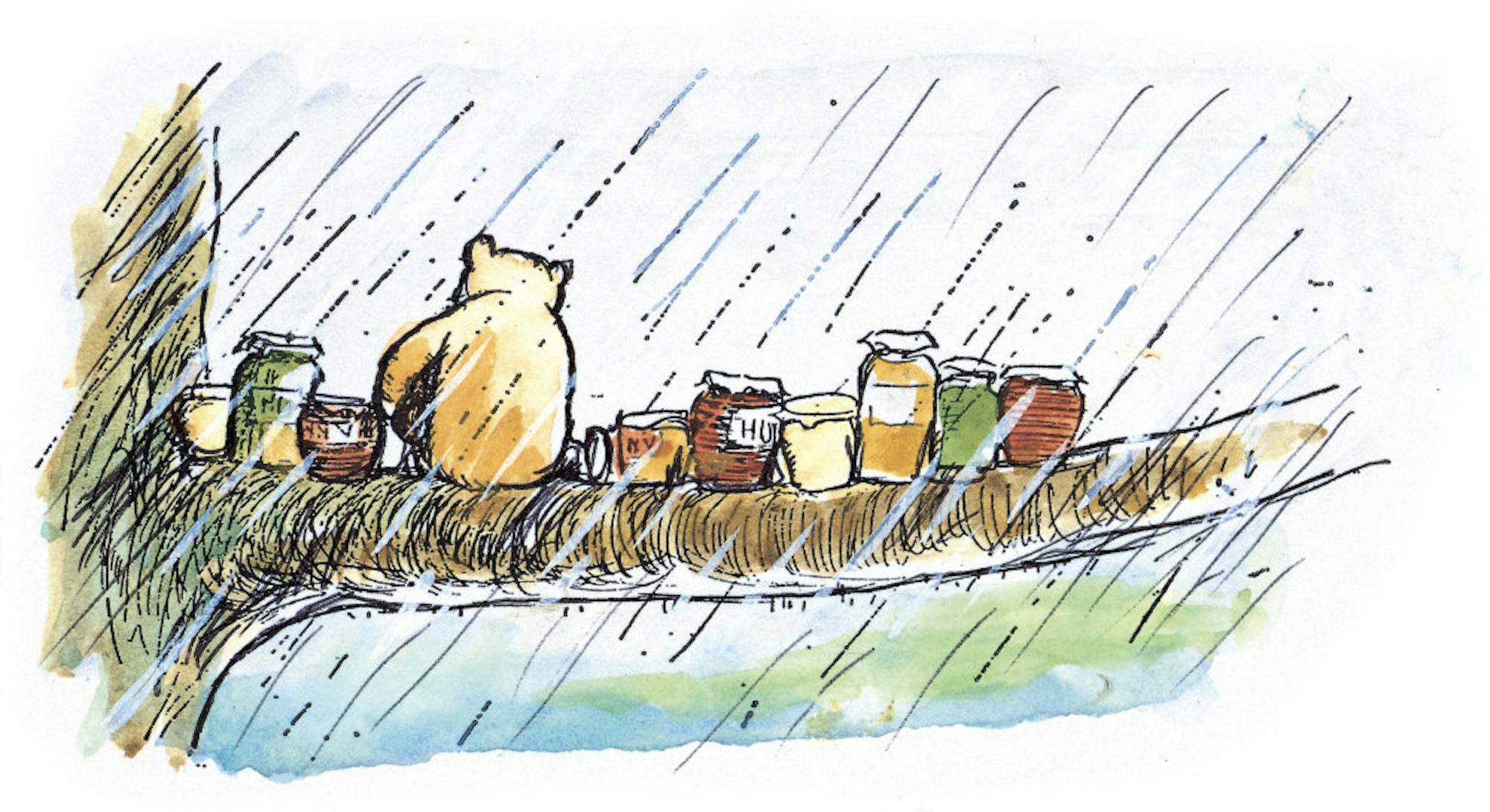Inside the Museum of Fine Arts (MFA), Boston, a hallway with larger-than-life blue balloons stuck to the ceiling leads the way to an enchanting exhibit. The MFA’s newest adventure, “Winnie-the-Pooh: Exploring a Classic,” runs from Sept. 22, 2018 to Jan. 6, 2019 in the Lois B. and Michael K. Torf Gallery. While at first glance it may seem aimed at children, it is unquestionably a timeless experience for all ages.
The interactive exhibit, organized by London’s Victoria and Albert Museum, explores the history of everyone’s favorite honey-loving bear, beginning with his first appearances in English author A.A. Milne’s “When We Were Very Young” (1924) and “Winnie-the-Pooh” (1926). There are original drawings by E.H. Shepard, wonderful pieces of Winnie-the-Pooh merchandise — including original stuffed toys — and priceless early editions.
At the very beginning of the exhibit, visitors learn that Milne created Pooh in the likeness of his son’s teddy bear and Shepard’s son’s bear. Milne’s son, Christopher Robin Milne, became the inspiration for Pooh’s very best friend. As the exhibit progresses, Milne’s world becomes immersive. The displays showcase original letters and notes describing Milne’s creative process, including the creation of Christopher Robin and Pooh’s other friends, like Piglet, Eeyore, Kanga and Roo, Owl, Tigger and Rabbit.
These walls are not plain old museum walls — they are sets. Like a theatrical production, the exhibit develops scene by scene, beginning in a simply lit room before flowing into a child’s bedroom — presumably Milne’s son’s — and then opening into a massive playground set deep in the Hundred Acre Wood. Wrapped inside tall trees cut straight from E.H. Shepard’s illustrations, the exhibit offers plenty to explore. Images and words from the novels find themselves scattered around the walls and hanging from the ceilings. It is as if the visitor is inside the books themselves.
There is a small door for children (or adults, if you try hard enough) to crawl through, a bell to ring, plenty of places to take pictures, a virtual pond with flowing twigs to grab, Eeyore’s well-built twig home, a giant staircase and a small slide. Different lights and sounds highlight the experience. It is incredibly immersive, allowing visitors the opportunity to explore the Hundred Acre Wood while reading about it. Expertly placed original notes and letters compliment the displays well.
One of the most captivating installations is the Make-Up-a-Monster tool, where some rotating pieces allow visitors to use a variety of words to name their own 100-Acre-Wood monster. This can be time-consuming — by the time you are satisfied, there may or may not be a line of children behind you impatiently waiting for a turn.
The implications of Winnie the Pooh and his iconic status are also presented, featuring details regarding the success of the books and the iconic status of Pooh, Robin and their friends. Disney’s 1966 short film “Winnie the Pooh and the Honey Tree” as well as future feature length films, short films and television shows are noted, but Milne’s novels are the focus of the exhibit. After all, the four volumes have been translated into over 50 languages. It is this success — the household name of Winnie the Pooh — that makes the MFA’s exhibit so personal for each and every visitor.
Milne’s literary craft is demonstrated in one particular section.There are examples of expressions in Shepard’s illustrations, discussion of exposition and composition, a look at narrative and character and details of page layout. At the end of the exhibit, a long hallway towards the exit wraps up the jubilant journey, allowing visitors the opportunity to sit with what they have read, seen and been part of.
“Winnie-the-Pooh: Exploring a Classic” outdoes itself. It ties together Winnie the Pooh’s literary past and ongoing cultural role to create something inarguably magical. It is reminiscent of Walt Disney World’s ride “The Many Adventures of Winnie the Pooh,” opening the 100 Acre Wood to a new generation and allowing adult visitors the chance to be children again. Tickets for "Winnie-the-Pooh: Exploring a Classic" are on sale on the MFA website. Tufts students may claim free tickets with their Tufts ID upon museum entry. Note that for safety reasons, visitors are admitted into the exhibit every 30 minutes, and the number of people let in per admission is limited.
'Winnie the Pooh: Exploring a Classic' brings out inner child in all

"Pooh sitting on his branch … beside him, ten pots of honey,” 1970 Ernest Howard Shepard (British, 1879–1976) Line block, and watercolor, hand-colored by E.H. Shepard
Summary
“Winnie-the-Pooh: Exploring a Classic” simply outdoes itself. It combines Pooh’s literary past and ongoing cultural role to create something inarguably magical.
5 Stars





